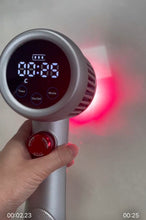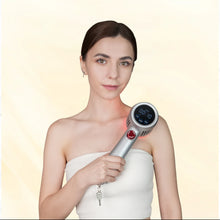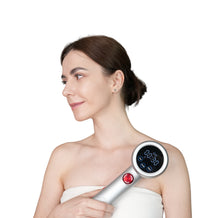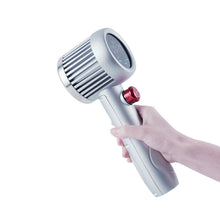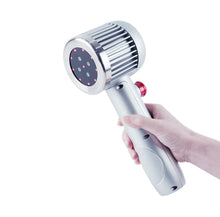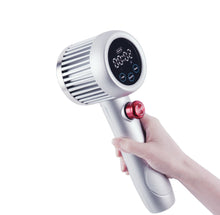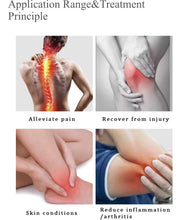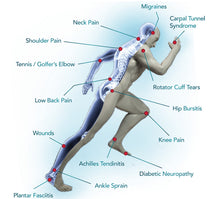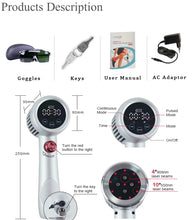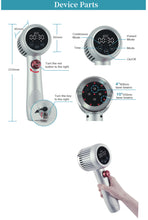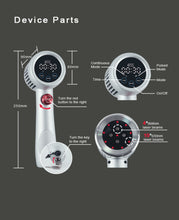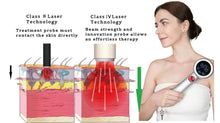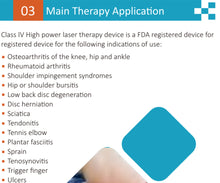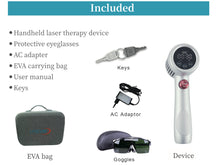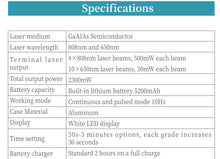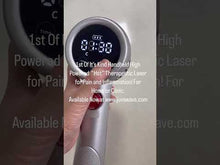
***we ship worldwide and will ship power supply based on customers country on order***
Introducing the game changing JuvaTherm Handheld High Powered Therapeutic Laser for Musculoskeletal Pain Relief!
The JuvaTherm Therapeutic Laser is the worlds first and only handheld FDA Class IV High Powered Laser Therapy that combines 3 gold standard therapeutic energy modes( Pulsed, Super Pulsed and Continuous Wave) in one portable medical grade device, allowing for customizable treatment programs and better and faster results.
About High Powered Laser Therapy:
Groundbreaking JuvaTherm Laser Therapy is a safe, natural and game changing field of healthcare that uses specific wavelengths of light (red and near-infrared) when delivered at the cellular level is absorbed and converted into raw energy that it uses to kickstart your body’s own natural healing processes without any dangerous drugs or surgery and the side effects of each!
Much like photosynthesis in a plant, the light that is transmitted via the laser into the damaged area helps stimulate certain processes within the body including boosting ATP(your body’s raw energy that it needs to heal itself) and helps provide relief to symptoms including pain, swelling, and limited range of motion.
High Powered Laser Therapy has been clinically proven to boost ATP by 80% or more so you can be on the road to a pain free life faster so you can resume your normal activities pain free.
And compared to lower powered laser therapy, the HPL laser is 24 times more powerful than low powered lasers and its effective penetration depth is more than 4 centimeters making it especially effective for treating both superficial and deep tissue conditions like low back or joint pain while low powered laser therapy has a depth of half a centimeter and can mainly help treat superficial and small tissues.
Cellular Pathways: High Powered Laser Therapy Ticks All the Boxes!
JuvaTherm utilizes dual wavelength super pulsing technology (660nm visible red laser diodes and 808 nm super-pulsed near infrared laser diodes) to be the only laser known to activate all three known cellular pathways simultaneously.
ATP Pathway(Accelerates Healing): Cells that lack energy are unable to participate in the healing process. Light energy is delivered to injured cells which in turn absorbs the light and converts it into food energy and uses it to replenish themselves.
Once cells are fully recharged they are able to replicate and divide, and build upon one another to heal the injured area. Theralase stimulates the mitochondria of the cell to produce more ATP (energy) thus repairing damaged tissue.
High Powered Laser Therapy stimulates the mitochondria of the cell to produce more Adenosine Tri Phosphate (ATP or basic cell energy) to accelerate tissue repair. (Proceedings of the National Academy of Science 2003)
Nitric Oxide (NO) Pathway (Decreases Inflammation)
When tissue injury occurs, the inflammatory process is initiated to immobilize the area to prevent further damage, providing us with an indication that the body is hurt.
This process is usually associated with pain caused by inflammation pressuring nerve endings. In order to reabsorb this interstitial fluid and decrease inflammation in the region, the body produces nitric oxide (NO), which has been proven to relax the lymphatic system causing it to become more porous allowing the reabsorption process to occur.
This process not only reduces inflammation but causes temporary vasodilation (increased diameter of capillaries) bringing much needed oxygen, fuel molecules and other metabolites to the injured tissue aiding in their natural healing.
Independent research proves that the proprietary JuvaTherm 808nm super-pulsed laser technology increases the production of nitric oxide (NO) by over 700%, increasing vasodilation and decreasing inflammation versus other competitive wavelengths. (Lasers in Surgery and Medicine, 2009).
Lipid Absorption Pathway (Removes Pain)
Pain results when a stimulus causes action potentials to rapidly propogate along a nerve cell. These actions potentials are primarily due to an expulsion of positively charged sodium ions (Na+) and an influx of potassium (K+) ions into the nerve cell altering the electrical potential across the membrane.
The peak absoption of lipids is in the 660nm to 808nm nm range. Laser light is thus directly absorbed by receptors within the bi-lipid cellular membrane of nerve cells.
Once absorbed, the laser light will increase the porosity of the cellular membrane allowing for a reabsorption of sodium ions and expulsion of potassium ions across the cellular membrane rebalancing the sodium-potassium pump and removing the pain signal at source.
3 Gold Standard Therapeutic Laser Modes in One Portable State of the Art Device:
- Super Pulsed: During Super Pulsed Mode, the laser fires rapidly on and off rapidly while delivering short but effective maximum doses of light to the intended area without ever building up heat or risking any thermal effect.
- Pulsed: When the laser is used in gated mode, it is cycling its continuous wave power on and off. It’s the best of both world in you are using both pulsed and continuous wave at the same time. Studies prove that both laser therapy is best when both modes and wavelengths are used in tandem.
- Continuous Wave: Continuous wave lasers deliver photobiomodulation therapy by having the laser “on” all the time. There is no period where the laser is “off” during the treatment. It is analogous to turning on a light to brighten a room.
The option to customize your treatment program allows for significantly better outcomes and faster results!
Conditions Commonly Treated:
- Arthritis
- Joint Pain
- Knee Pain
- Back Pain
- Neck Pain
- Shoulder Pain
- ACL Tear
- Tendonitis
- Plantar Fasciitis
- Tennis Elbow
- Carpal Tunnel
- Sports Injuries
- Fibromyalgia
…and many more.
Combine with other therapies such as our CryoFreeze Pain Relief Gun for an “Icy Hot” treatment plan and even better results.

https://juvawave.com/products/juvafreeze-portable-cryotherapy-gun?_pos=1&_psq=cry&_ss=e&_v=1.0
FAQ’s
How does Class 4 Laser Therapy Work?
The wavelength of the laser used in Class 4 high powered laser therapy penetrates deeper and more efficiently than the Class 3 laser allowing it to pass energy to the nerve, muscle, ligament, and tendon tissue in a short amount of time.
In fact, most sessions range from 2-6 minutes which means you can treat injured tissue in multiple areas in a single session thus improving your results. On average you’ll perform 2 sessions per week for 4-6 weeks.
Class 4 high powered laser therapy stimulates the production of ATP (adenosine triphosphate) which drives many of the processes within our cells. This increased production of ATP helps speed up the healing process within cells.
As a result of increased ATP production the patient experiences an improvement of symptoms, including reduced pain, swelling, and range of motion and of course, the heat from the laser is soothing as well.
Is laser therapy painful? What does laser therapy feel like?
Laser therapy treatments must be administered directly to skin, as laser light cannot penetrate through layers of clothing.
You will feel a soothing warmth as the therapy is administered. Many patients receiving JuvaTherm Therapy Laser treatments report enjoying the experience, especially when a massage-ball treatment head is used to deliver what is often referred to as a “laser massage.”
Patients receiving treatments with higher-power lasers also frequently report a rapid decrease in pain. For someone suffering from chronic pain, this effect can be particularly pronounced.
Is laser therapy safe?
Class IV high powered laser therapy devices were cleared in 2004 by the FDA for the safe and efficacious reduction of pain and increasing micro-circulation. Therapy lasers are safe and effective treatment options to reduce musculoskeletal pain due to injury. The biggest risk to injury during laser therapy treatments is to the eye, so certified protective laser therapy goggles are required.
How long does a therapy session last?
Treatments are usually 3-10 minutes depending on the size, depth, and acuteness of the condition being treated. High-power lasers are able to deliver a lot of energy in a small amount of time, allowing therapeutic dosages to be achieved quickly. For patients and clinicians with packed schedules, fast and effective treatments are a must.
How often will I need to get treated with laser therapy?
Most clinicians will encourage their patients to receive 2-3 treatments per week as the therapy is initiated. There is a well-documented support that the benefits of laser therapy are cumulative, suggesting that plans for incorporating laser as part of a patient’s plan of care should involve early, frequent treatments that may be administered less frequently as the symptoms resolve.
How many treatment sessions will I need?
The nature of the condition and the patient’s response to the treatments will play a key role in determining how many treatments will be needed. Most laser therapy plans of care will involve 6-12 treatments, with more treatment needed for longer standing, chronic conditions. Your doctor will develop a treatment plan that is optimal for your condition.
How long will it take until I notice a difference?
Laser therapy works on a case by case basis and most people will respond after 6-12 treatments.
Do I have to limit my activities?
Laser therapy will not limit a patient’s activities.
Class 4 High Powered Laser Therapy Benefits
The benefits of class 4 high powered laser therapy include reduced pain and swelling as well as improved range of motion but a class 4 high powered laser has some very interesting effects that we don't notice as obviously.
A class 4 high powered laser increases tissue regeneration which is why you heal faster but it also accelerates soft tissue and bone repair.
High-power lasers are able to deliver a lot of energy in a small amount of time, allowing therapeutic dosages to be achieved quickly.
This kind of laser therapy can also improve nerve regeneration & function as well as impact your cells to increase cell metabolism, enzymatic responses, collagen production, and promote angiogenesis (the creation of new blood vessels).
So yes, you walk away from a class 4 high powered laser therapy treatment feeling better but the therapy continues to work at the cellular level to an accelerate your bodies own natural healing process after your treatment is finished and in between each session
Higher powered lasers will also allow clinicians to have the versatility to treat injured tissue in multiple areas in a given session, which greatly improves the overall effectiveness of the laser when adding it to a plan of care.
What are the contraindications for laser therapy?
The following are contraindications with laser therapy.
- Do not treat over growth plates in children.
- Do not treat pregnant patients over the abdominal area or the low back/ pelvic area.
- Avoid treating around glandular tissue (such as thyroid, testes, ovaries).
- Do not treat over pacemakers or internal pain pumps.
- Do not treat patients taking photosensitive medications (such as steroids or antibiotics)
What are the side effects of laser therapy?
Based on peer-reviewed literature, there are no known significant side effects from laser therapy for most conditions. Increased blood flow is a positive benefit associated with laser therapy that can cause the skin to get flush and the feeling of warmth. These changes are short-lived, typically lasting for up to a few hours. Improper dosing can lead to increased swelling for acute injuries where there is a lot of inflammation present as well as increased nerve-related pain for certain conditions when irritable nerve tissue is over stimulated. This is usually correctable by adjusting the treatment settings.
On these rare occasions, the setbacks usually reverse themselves within 24-36 hours. Understanding proper dosing parameters minimizes this phenomena.
Can low level laser therapy be used with other modalities/treatments?
Yes, it generally works well with other modalities that are designed to promote tissue repair. Examples might include blood flow restriction and shockwave devices. The mechanisms that are associated with these modalities work well with laser therapy. Generally using modalities that are designed to provide cryotherapy which generally reduce blood flow and promote vasoconstriction are not recommended as adjunctive therapies with laser.
Can laser be effective as a post-surgical treatment for pain?
Absolutely! Some of the most consistently reported benefits of laser therapy are related to reduced pain after treatment. Research has shown that PBM can speed up the healing process of certain tissues through increased cellular metabolism. For post-surgical patients, appropriate doses of light energy can be delivered to effectively reduce pain, without negatively impacting the body’s natural healing process.
Can laser be used over metal/implants?
Yes, laser can be used over metal implants/ hardware. At the irradiance levels used with Juvawave equipment, light will simply bounce off of metal. There will be no heating that takes place at depth when using LightForce® lasers within recommended parameters.
Is laser effective for treating arthritis?
The suffix, –itis comes from the Greek that denotes inflammation. Several studies have shown that laser is an excellent therapy to help address the symptoms related to both osteo and rheumatoid arthritis. While it will not restore damaged cartilage, it can help improve ROM of the affected joints and help reduce pain so that functional levels can be maintained, NSAIDS can be reduced, and in some cases, more invasive procedures can be delayed or prevented.
Is there any literature supporting the use of low level laser therapy (LLLT) in rehabilitation?
Yes, there is a growing body of peer-reviewed clinical research supporting the use of Class 4, deep tissue lasers as a safe and effective treatment option for a myriad of conditions in rehabilitation. This body of literature includes numerous randomized control trials.
As of 2020, a search on Pubmed.com yielded over 7500 publications on “Low Level Laser Therapy” and over 1200 articles on the more recently coined term “Photobiomodulation”.
What does the Laser feel like?
We find that many patients think that laser therapy will hurt and they're pleasantly surprised to learn that they will feel some soothing warmth in the area we're treating but certainly no pain.
Class 4 lasers provide pain-free relief to many of our patients and can also be used in conjunction with other treatments like shockwave therapy.
SAFETY
Juvawave therapy lasers are cleared by the FDA and adhere to strict ISO standards in order to provide you with a safe, non-invasive treatment option and effective alternative to drugs and surgery.
Low Level Laser Therapy (Including PBM) Research Articles:
LLLT or Low Level Laser Therapy: 7,364
Photobiomodulation (PBM): 1,151
Laser Therapy (Including PBM) Research Articles By Year
*Data According to PubMed
“Clinicians should consider the use of low-level laser therapy to decrease pain and stiffness inpatients with Achilles tendinopathy.” – APTA
“Laser therapy is beneficial in treatment of neck pain.” – WHO
Specs:
Laser Medium: GaAIAs Semiconductor
Laser Wavelength: 808nm and 650nm
Terminal Laser Output:
4×808nm laser beams
500mW each beam 10×650nm laser beams
30mW each beam
Total Output Power: 2300mW
Battery Capacity: Built-in lithium battery 5200mAh
Case Material: Alumina
Lens Material: Focus lens
Display: White LED display:
Time Setting: 30s-3 minutes options
each grade increases 30 seconds
Battery Charger:
European standard
American standard
2 hours on a full charge
Package includes:
- Host * 1
- Keys * 1
- Goggle * 1
- AC Adaptor * 1
- Case *1


















